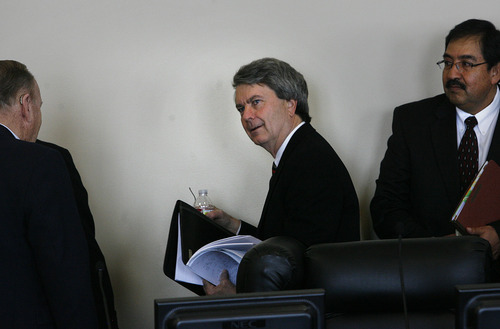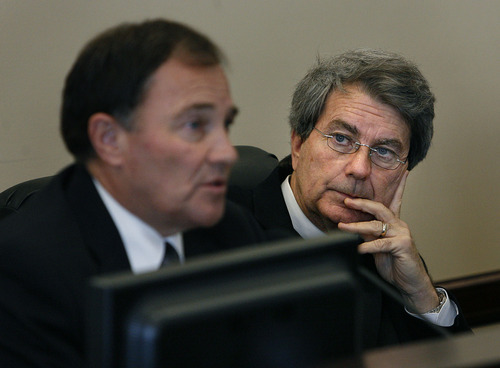This is an archived article that was published on sltrib.com in 2011, and information in the article may be outdated. It is provided only for personal research purposes and may not be reprinted.
Utah officials and a hostile crowd at the state Capitol let the Obama administration know what they think of its new wildlands protection policy Friday when the Bureau of Land Management director came to town.
"Illegal," some said of Secretary of the Interior Ken Salazar's December announcement that the agency would resume identifying for-protection areas with wilderness characteristics.
Economically unsettling, others said. A policy formed "in the shadows," according to the governor.
"If we've got to do it somehow in the shadows," Gov. Gary Herbert said to applause at a meeting of his Balanced Resources Council, "then it probably is not the right thing to do."
BLM Director Bob Abbey — having agreed to the governor's request to come to Utah and explain the plan to protect solitude in areas that have no legal protection — spent most of an hour and a half session taking criticism from the council and groans from the audience.
About 150 people filled a Senate Building committee room for the meeting, most of them sporting "Stop the Land Grab" buttons. Environmentalists, who showed up later than many off-roaders, listened from spillover rooms elsewhere on the Capitol grounds.
Herbert asked Abbey to explain Salazar's policy, which marked a reversal of a Bush administration deal struck with then-Utah Gov. Mike Leavitt that ended the BLM's identification of lands worthy of congressional consideration for wilderness designation.
Now, the BLM can again protect lands until Congress acts, Abbey said, provided they cover at least 5,000 acres, lack roads or significant human disturbance and offer excellent opportunities for recreational solitude.
At question in Utah are six area-management plans approved late in the Bush administration that identified 2.8 million acres with wilderness qualities but protected only 400,000 of them, Abbey said. The BLM now will determine whether more of those lands should be shielded from development.
Part of the agency's multiple-use mandate is to protect some lands for future generations, Abbey said. "It's not just about today."
The BLM boss drew groans from the audience when he noted that the regional planning process would determine how much land deserves protection and said, "We're not creating de facto wilderness."
Former Rep. Jim Hansen, a Utah Republican, won applause when he told Abbey that protecting new lands without congressional approval is illegal.
Only Congress can designate wilderness for perpetual protection from roads and development, but federal agencies routinely preserve them under their planning processes. Agencies previously established wilderness study areas for consideration. Salazar's policy does not call for more study areas, but does allow for protection of wilderness characteristics elsewhere.
Abbey said such preservation is within the agency's administrative authority.
"This action was not taken in the shadows," he said.
Friday's encounter saw a clash between two Balanced Resource Council members who have served in Abbey's job under previous administrations. Pat Shea, a BLM director during the Clinton administration, objected when Kathleen Clarke, a director during the Bush administration, asked to allow Hansen to speak, even though he is not a council member.
Council Chairman Ted Wilson ruled Hansen could speak, and Shea left the meeting.
Clarke told Abbey the land-management pendulum that swings from development in one administration to preservation in another threatens local economies.
"We will cause industry to flee this state," she warned.
Abbey responded by noting that 5 million Utah acres are under lease by oil and gas companies, but the companies are drilling only 1 million acres so far.
Some trail riders worry about what federal land managers will do. Layton resident Lynn Blamires said 5,000 acres — small by wilderness standards — is a big area to keep off-limits from vehicles.
"There are very few people," he said, "who have enough vacation time and money to invest in an activity to see that whole parcel on foot."
But Bryson Garbett, president of Garbett Homes and a former Republican legislator, joined the Southern Utah Wilderness Alliance in a pre-meeting news conference to thank Salazar for his move. He recalled a trip along eastern Utah's White River in the fall during which his son found a well-preserved American Indian ruin. He could see 700-year-old fingerprints in the adobe, he said.
"The only way to protect the scenery and these kinds of sacred sites," Garbett said, "is to keep them wild."
Wildlands policy
The Department of the Interior's policy enables administrative protection of lands with wilderness qualities that are not already protected as wilderness study areas. In Utah:
Up to 9 million acres are ensnared in the wilderness debate.
3.2 million of those acres already have protection as official wilderness study areas.
Six eastern and southern Utah management plans identified another 2.8 million acres worthy of protection, but offered protection to only 400,000 acres.









